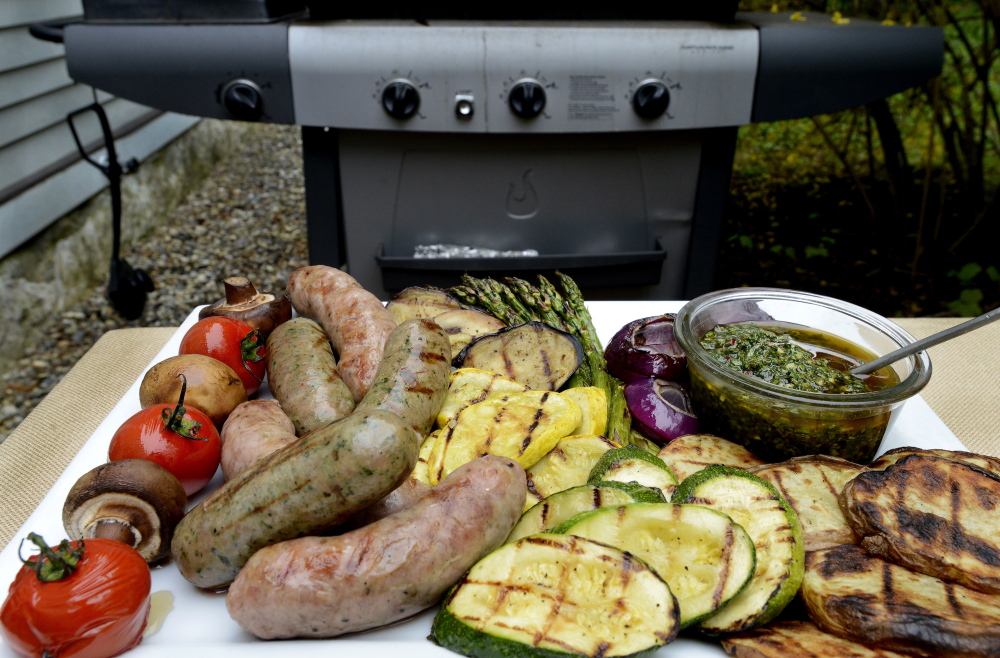The University of Michigan Department of Engineering has a YouTube video that takes a nerdy dive into the environmental impact of backyard barbecuing.
The amateur filmmakers explain that all grills emit carbon dioxide, gas grills less so than charcoal ones. They say warming up the grill as little as possible, simultaneously cooking as much food as your grates allow and keeping the cover on are practices that increase the efficiency of your grill. And they argue that green-minded grillers should take into account the carbon footprint of the products they place on the grates, understanding that less meat and more vegetables is the way to go.
My efficient grilling skills arose out of necessity. I was having a dinner party and wasn’t entirely sure how much propane I had at my disposal. There was no time to refill the tank, as guests were due in 20 minutes, and I still needed to shower. Who am I kidding? That scenario didn’t happen just once. It’s my modus operandi for summertime entertaining when cooking local bounty and lolling on lovely beaches pull at me in equal measure, when I always have a houseful of guests cashing in on my hospitality and Maine locale, and when I never remember to check the tank.
My grilling game plan entails hitting the market early, buying for each person expected at the table either five ounces of local fish or a single sausage, as both are proteins that cook more quickly than solid cuts of chicken, beef, lamb or pork.
I grab an abundance of grill-friendly vegetables – zucchini and summer squash, eggplant, waxy potatoes, sweet onions, asparagus and cherry tomatoes; the ingredients for kale chimichurri sauce (recipe below right); and a good loaf of bread. The protein goes on ice; the bigger vegetables get sliced into ¼-inch ovals and tossed with olive oil, salt and garlic; the smaller ones get skewered together so they don’t fall through the grates; and, the ingredients for the sauce are chopped, combined and set on the counter so they can get to know each other better.
And we go to the beach.
When we return, I fire up the grill and put the sliced vegetables on first, turning them as soon as they are nicely marked by the grates. When both sides are marked, I stack the slices on the upper rack of the grill (or on a metal plate nearby) to let the residual heat soften their insides without charring their outsides as continued time over the flame would do. The skewered vegetables and quick-cooking proteins get brushed lightly with oil, placed on the grill and covered until the vegetables are slightly soft and the fish or sausages cooked through.
Everything goes on one platter and gets passed around with the sauce and bread for sopping it up.
KALE CHIMICHURRI SAUCE
Chimichurri is an herby Argentinian condiment traditionally served with parrillada, a mix of grilled meats. But it’s also great with grilled vegetables and as a spread on bread. You can pulse all of the ingredients in a food processor if you are short on time, but chopping each ingredient separately and letting them meld over a period of hours improves both taste and texture. I add kale and reduce the amount of oil typically called for to increase the nutrients and reduce the fat.
Makes 2 cups
1 cup finely chopped kale
¼ cup fresh finely chopped herbs of your choice (parsley, oregano, basil, thyme, rosemary)
5 garlic cloves, minced
1½ teaspoons kosher salt
1 teaspoon red chili flakes (chopped fresh chilies work well too)
½ teaspoon black pepper
1 teaspoon lemon zest
3 tablespoons white wine or sherry vinegar
Pinch of sugar
½ cup of good olive oil
Mix all ingredients and let them sit for at least 2 hours before serving.
Christine Burns Rudalevige is a food writer, recipe developer and tester, and cooking teacher in Brunswick. She writes about feeding her family Maine seafood at www.familyfish.net. Contact her at cburns1227@gmail.com.
Send questions/comments to the editors.


